- nsurance
- Debt Consolidation
- Term life insurance
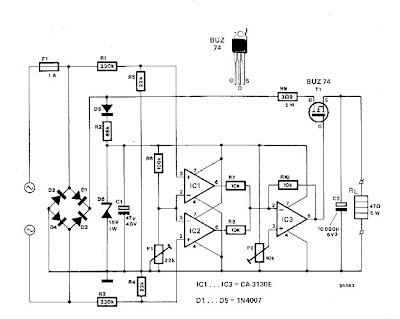 |
| Schematics MOSFET use BUZ74 and IC CA3130E |
For example a 5V regulated supply:

Each of the blocks is described in more detail below:
 |
| Schematics MOSFET use BUZ74 and IC CA3130E |
For example a 5V regulated supply:

Each of the blocks is described in more detail below:

The varying DC output is suitable for lamps, heaters and standard motors. It is not suitable for electronic circuits unless they include a smoothing capacitor.
Further information: Transformer | Rectifier
 Some electronic circuits require a power supply with positive and negative outputs as well as zero volts (0V). This is called a 'dual supply' because it is like two ordinary supplies connected together as shown in the diagram.
Some electronic circuits require a power supply with positive and negative outputs as well as zero volts (0V). This is called a 'dual supply' because it is like two ordinary supplies connected together as shown in the diagram.Dual supplies have three outputs, for example a ±9V supply has +9V, 0V and -9V outputs.

The smooth DC output has a small ripple. It is suitable for most electronic circuits.
Further information: Transformer | Rectifier | Smoothing

The regulated DC output is very smooth with no ripple. It is suitable for all electronic circuits.
Further information: Transformer | Rectifier | Smoothing | Regulator
Step-up transformers increase voltage, step-down transformers reduce voltage. Most power supplies use a step-down transformer to reduce the dangerously high mains voltage (230V in UK) to a safer low voltage.
The input coil is called the primary and the output coil is called thesecondary. There is no electrical connection between the two coils, instead they are linked by an alternating magnetic field created in the soft-iron core of the transformer. The two lines in the middle of the circuit symbol represent the core.
Transformers waste very little power so the power out is (almost) equal to the power in. Note that as voltage is stepped down current is stepped up.
The ratio of the number of turns on each coil, called the turns ratio, determines the ratio of the voltages. A step-down transformer has a large number of turns on its primary (input) coil which is connected to the high voltage mains supply, and a small number of turns on its secondary (output) coil to give a low output voltage.
| turns ratio = | Vp | = | Np | and | power out = power in |
| Vs | Ns | Vs × Is = Vp × Ip |
| Vp = primary (input) voltage Np = number of turns on primary coil Ip = primary (input) current | Vs = secondary (output) voltage Ns = number of turns on secondary coil Is = secondary (output) current |
| There is more information about rectifiers on the Electronics in Meccano website. |
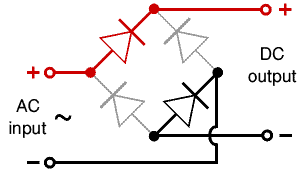 |  |
| Bridge rectifier Alternate pairs of diodes conduct, changing over the connections so the alternating directions of AC are converted to the one direction of DC. | Output: full-wave varying DC (using all the AC wave) |
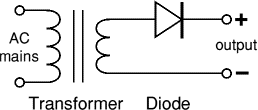 | 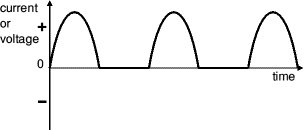 |
| Single diode rectifier | Output: half-wave varying DC (using only half the AC wave) |

Note that smoothing significantly increases the average DC voltage to almost the peak value (1.4 × RMSvalue). For example 6V RMS AC is rectified to full wave DC of about 4.6V RMS (1.4V is lost in the bridge rectifier), with smoothing this increases to almost the peak value giving 1.4 × 4.6 = 6.4V smooth DC.
Smoothing is not perfect due to the capacitor voltage falling a little as it discharges, giving a small ripple voltage. For many circuits a ripple which is 10% of the supply voltage is satisfactory and the equation below gives the required value for the smoothing capacitor. A larger capacitor will give less ripple. The capacitor value must be doubled when smoothing half-wave DC.
| There is more information about smoothing on the Electronics in Meccano website. |
| Smoothing capacitor for 10% ripple, C = | 5 × Io |
| Vs × f |
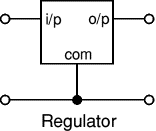 | 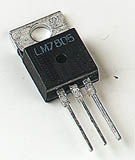 |
| Voltage regulator Photograph © Rapid Electronics
|
Many of the fixed voltage regulator ICs have 3 leads and look like power transistors, such as the 7805 +5V 1A regulator shown on the right. They include a hole for attaching a heatsink if necessary.
Please see the Electronics in Meccano website for more information about voltage regulator ICs.
| zener diode a = anode, k = cathode |
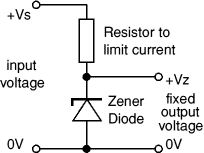 |
The resistor limits the current (like an LED resistor). The current through the resistor is constant, so when there is no output current all the current flows through the zener diode and its power rating Pz must be large enough to withstand this.
Please see the Diodes page for more information about zener diodes.
Choosing a zener diode and resistor:
| There is more information about regulators on the Electronics in Meccano website. |
Tiada ulasan:
Catat Ulasan